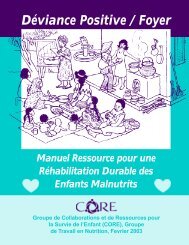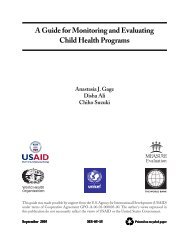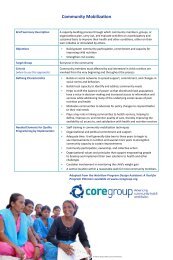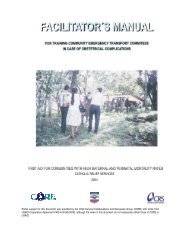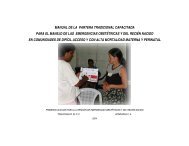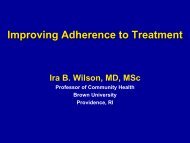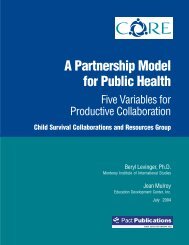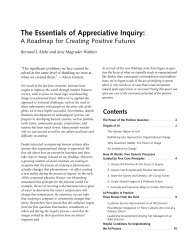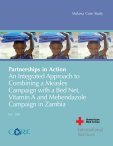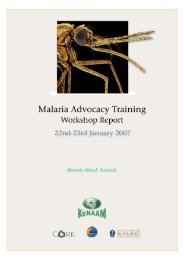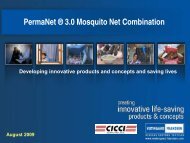Planning Document for Concurrent Session: - CORE Group
Planning Document for Concurrent Session: - CORE Group
Planning Document for Concurrent Session: - CORE Group
You also want an ePaper? Increase the reach of your titles
YUMPU automatically turns print PDFs into web optimized ePapers that Google loves.
<strong>CORE</strong> <strong>Group</strong> Fall Meeting 2010<strong>Concurrent</strong> <strong>Session</strong>: “mHealth and CCM/Community Child Health: Charting the Way Forward”Tuesday, September 14, 2010 from 11:00 am – 12:30 pm<strong>CORE</strong> <strong>Group</strong> facilitators: Ann Hendrix-Jenkins and Shannon DowneyDescriptionThis working session brought together experts and those interested in community child health programs (includingcommunity case management of sick children (CCM)); operations/implementation research; and/or mobile technologies<strong>for</strong> health (mHealth). Participants outlined community child health programmatic barriers and challenges, and creativelydevised mHealth solutions in small groups. Each group proposed at least one idea and assessed the feasibility.MHealth/In<strong>for</strong>mation technology and community health experts engaged in dialog to enrich understanding of eachother’s perspectives. Participants generated specific, promising mHealth [1] applications <strong>for</strong> use in Community ChildHealth/ Community Case Management [2] (CCM) programs.Participants self selected among small groups that looked at specific critical steps <strong>for</strong> CCM programs and brainstormedaround the related program barriers and then possible mHealth solutions.Small <strong>Group</strong> Work Results1. <strong>Group</strong> I: Assigned to devise mHealth applications to facilitate the following steps:- Caretaker correctly recognizes malaria/pneumonia/diarrhea/malnutrition danger signs- Caretaker promptly seeks care from trained CHW- CHW provides appropriate assessment and diagnosisCritical Step: Caretaker correctly recognizes malaria/pneumonia/diarrhea/malnutritiondanger signsMajor ConstraintEx. Can be difficult to teach signs of conditionSome groups have cultural and religious beliefs that aredifferentIlliteracy—don’t have access to health in<strong>for</strong>mation in a<strong>for</strong>m they can understandHealth in<strong>for</strong>mation may not be given to all theappropriate peopleLack of knowledge of danger signs that necessitatecalling community health workerCaregiver and other family members/decision makerswithout access to knowledgeSigns confusing (i.e. diarrhea + teething)mHealth SolutionEx. Train caretaker using a mobile video of a childwith conditionVideos on mobile phones : Show videos of figures ofauthority to back up what CHW is promoting –– CHWcan bring this message along on home visits[1] mHealth refers to the use of mobile technologies (e.g., cell phones, PDAs and netbooks) within medical and public healthprograms.[2] Community Case Management refers to community-based finding, diagnosis, treatment and/or referral of children suffering fromthe most common causes of illness and death, including diarrhea, malaria and pneumonia.
Doesn’t recognize urgency – “normal”Critical Step: Caretaker promptly seeks care from trained CHWMajor ConstraintEx. Caretaker may not be able to find CHW or childmay be too sick to travelNo trained CHWDon’t know where CHW isNot allowed to goCaregiver has other responsibilitiesDoes not have capacity to take the childGoing somewhere else be<strong>for</strong>e going to CHWWait too long be<strong>for</strong>e going to CHWmHealth SolutionEx. Caretaker calls the CHW to find their location orrequest that they come to the homeGPS function on phoneText message (sms)Critical Step: CHW provides appropriate assessment and diagnosisMajor ConstraintEx. CHW may not follow diagnostic algorithmLack of rigor when asking about danger signsTake shortcutsDoesn’t have time to provide diagnosis because othersare visitingNot well trained, supervised, refreshed, or checkedNo RDTs, no timersCan’t countConflict with local practices/beliefsmHealth SolutionEx. CHW follows a phone-based job aidsms <strong>for</strong> remote diagnosisJob aids with steps <strong>for</strong> diagnosisVoice message, foster peer-support or Dr. or Nurse callto provide feedback on proposed interventions (more<strong>for</strong> mentorship than supervision)Mobile apps to do calculationsTake pictures of blood samplesMobile apps: particularly respiration app2. <strong>Group</strong> II: Assigned to devise mHealth applications to facilitate the following steps:- CHW has treatment in stock and dispenses it correctly- CHW provides appropriate health education and counseling- Caretaker adheres to treatment planCritical Step: CHW provides appropriate health education and counselingMajor ConstraintEx. CHW may not give adequate adviceData collection in timely mannermHealth SolutionEx. CHW follows a phone-based job aidSimple program on cell phoneFall Meeting 2010: mHealth and CCM <strong>Concurrent</strong> <strong>Session</strong> Page 2 of 9
Illiteracy, especially working with CHW who do homevisits.Technology challenge: too expensive to respond,electricity, connectivity with internetPictures <strong>for</strong> reconciling response- Simple and user-friendly- Solar powered batteries- Charger kiosk: free phone charging with healthtalk- Use of video3. <strong>Group</strong> III: Assigned to devise mHealth applications to facilitate the following steps:- CHW refers child to health facility <strong>for</strong> severe illness- Caretaker seeks timely follow-up- CHW provides timely and accurate data on patientCritical Step: CHW refers child to health facility <strong>for</strong> severe illnessMajor ConstraintEx. Transportation may not be available oraf<strong>for</strong>dableKnowledge of symptoms (CWH) need of a referenceAvailability of health facility - distance, staffed withcompetent health professionals, af<strong>for</strong>dableHow to manage in home when care giver is absent, whogoesMedication and supplies availableCommunicate back to CHWmHealth SolutionEx. Call <strong>for</strong> emergency transport; reimbursecaretaker with mobile moneysmsCall health facility to notify/confirm referralNotify that Pt. was seenPlan of careReminder <strong>for</strong> RxMoney transfers4. <strong>Group</strong> IV: Decided to address the issue of community mobilization <strong>for</strong> demand creationCritical Step: Demand creation <strong>for</strong> CCM services within populations with low literacyMajor ConstraintNew CCM services, there<strong>for</strong>e use of them is not a normDoes supply meet demand?mHealth SolutionAdvertise via television or radioReverse 911 <strong>for</strong>mat: calling all parents in an area wherethere is a problem, e.g. diarrheal illnessRegistry of all phone numbers in village could be used inmany ways: e.g. weekly robo-callsSimple text or recorded message that doesn’t costanything to receiveToll free call-in numbersCHW transfer minutes to caretaker’s phone as incentiveFall Meeting 2010: mHealth and CCM <strong>Concurrent</strong> <strong>Session</strong> Page 3 of 9
Charger kiosk in exchange <strong>for</strong> education/servicesSolar power chargeriPad/Kindles – videos <strong>for</strong> educationIcon based-photos as teaching toolOther ideas:- Incoming calls are free- With illiterate populations – use of pictures and images, audio messages, pre-set buttons- Air time provided- E-banking- E-IMCI- Commodity management groups, use PDAs and collaborate- Based on expressed need from communities- Potential of PPP <strong>for</strong> communicationFeasibility Exercise:Less ExpensiveLow demand = registry withrecorded callsMobile phone communicationbetween CHW and HealthFacilityText medication/Rx reminders tocare givers and CHWLess ImpactDiagnostic aids:- images and videos on phonesto facility- ability to submit images <strong>for</strong>remote diagnosticsLow demand=CHW transferminutes as incentives- charging solar kiosk in exchange<strong>for</strong> educationMore ImpactStream training video to phonewith real-time interactionE-money transfer <strong>for</strong>transportation costs, incentives<strong>for</strong> CHWPictorial applications <strong>for</strong> illiteracyMore ExpensiveFall Meeting 2010: mHealth and CCM <strong>Concurrent</strong> <strong>Session</strong> Page 4 of 9
APPENDIX 1: <strong>CORE</strong> <strong>Group</strong> Spring Meeting 2010 Summary—CCMCommunity Case Management <strong>Concurrent</strong> <strong>Session</strong> – Small <strong>Group</strong> Work Write-UpSpeakers: Yolanda Barbera and Amina Issa Mohamud, IRC; Jeanne Koepsell, Save the Children; and Megan Wilson, PSIThree <strong>CORE</strong> <strong>Group</strong> Members, IRC, PSI and Save the Children who are all working on CIDA-funded CCM programs in multiplecountries, presented on lessons being learned through providing life saving interventions through CCM and on the related impact onunder-five mortality. Presenters and participants worked in small groups to address barriers and challenges to CCM scale-up andpossible solutions and best practices. They focused on four different areas and the ideas generated during the group work arewritten-up below.Small <strong>Group</strong>s:I. Procurement & Supply Chain ManagementBarriers & Challenges- Poor <strong>for</strong>ecasting- Government policies and requirementsSolutions & Best Practices- Coordination between community, facility and governments- Partnering approach with government <strong>for</strong> the startII.TrainingBarriers & Challenges- If training by specialty then training would be altered- Cost of training- Length of trainingSolutions & Best Practices- Opportunity costs of attending- How to keep them interested/coming (paid, volunteer)- Changing ideas/activities to newer techs (BC @ Ministry Level)- Having support and consensus of partners, roles, expectations- Supervision (more + better)III. SupervisionBarriers & Challenges- Few/no civil service supervision- Lack of increased attitude <strong>for</strong> supportive supervision (audit)- Lack of $ and time to support supervision (transport, etc.)Solutions & Best Practices- Advocate <strong>for</strong> increase resources <strong>for</strong> supervision- Training on supportive supervision at TOP Levels- Quality improvement verification checklist (QIVC)IV. CHW – Motivation & IncentivesBarriers & Challenges- Competing priorities- Competing survival strategies- Different incentive structures – NGOs, governments- Campaign vs. routine- Continuity – funding stops- SustainabilitySolutions & Best Practices- Social support- Positive supervision- Info fed back- Community mobilization and engagement to support CHWs – coherent and integrated- Mentoring to retain knowledge- New challenges <strong>for</strong> CHWs- Volunteer contract – fixed term- Basket approach/other things to offer- Meet other CHW needs- Provide CHW with other skills- Volunteers prioritized <strong>for</strong> livelihood benefits- CHW set up loan groups post training in the area- Pay <strong>for</strong> serviceFall Meeting 2010: mHealth and CCM <strong>Concurrent</strong> <strong>Session</strong> Page 5 of 9
APPENDIX 2: <strong>CORE</strong> <strong>Group</strong> Spring Meeting 2010 Summary—CCM —mHealthmHealth <strong>Concurrent</strong> <strong>Session</strong>—Plenary: mHealth… Help or Hype?Key Messages1. Some of the most common ideas <strong>for</strong> mHealth in community health programming: Behavior change communicationsvia calls and text messages; monitoring and evaluation/data collection; health system communications, e.g. communityhealth worker visit scheduling, counseling and follow-up, technical support <strong>for</strong> community health workers from clinicalstaff; appointment reminders; treatment support <strong>for</strong> child morbidity, HIV and TB treatment; health worker training.2. The world is going mobile. There have been huge growth rates in Africa. The $10 cell phones and $8 solar panels arebridging the last 100 mile gap from the farthest health facilities, saving fuel and transport time.3. The focus is not about mHealth or eHealth but rather health solutions and how technology can help. mHealthcomplements, rather than replaces, activities.4. Mobile money is on the upsurge. This can be used <strong>for</strong> payroll, transport costs, etc. It is available in remote locations,right where our beneficiaries live.5. Many community health practitioners have been slow to consider mHealth applications because they are used toworking in very low resource settings. However, there are realistic, efficient and effective uses of mHealth possibly noweven in many low resource settings.Surprising Twist/New LearningA systematic review on mHealth implementation and research has just been completed at JHU. The technology is stillvery new, so while there are some promising results these are mostly from pilots.There is a whole ecosystem that has to be in place <strong>for</strong> mHealth to work.Unanswered Questions/GapsThere is a need to:• be more rigorous in the kinds of evaluations being done, to focus on health outcomes or impacts where possible• identify the metrics needed to measure progress in mHealth• frame research questions within a larger context.• The only way to get to good systems that will work across organizations is to set standards.The Future—What next <strong>for</strong> <strong>CORE</strong> <strong>Group</strong> in this topic area?There is a community being built around mHealth work which is looking <strong>for</strong> ideas. It is critical to root mHealthapplications in a real understanding of the real needs of the target population.There are discussion groups running on various topics, include a <strong>CORE</strong> <strong>Group</strong> mHealth interest group listserv. There areseveral mHealth Working <strong>Group</strong>s. One at JHU/CCP includes NGOs around the world. Anyone can join. (Contact KellyKiesling at kkeislin@jhuccp.org)mHealth Alliance’s Health Unbound ef<strong>for</strong>t aims to get all the in<strong>for</strong>mation mHealth in one place. Refer tohttp://www.mhealthalliance.org/Bonus: What do you want the outside world to know?As these systems are built, they should be designed in ways that enable them to link and talk together.Fall Meeting 2010: mHealth and CCM <strong>Concurrent</strong> <strong>Session</strong> Page 6 of 9
APPENDIX 3: mHealth Fact SheetWhat is mHealth?mHealthFact SheetAuthors: Peggy D’Adamo (USAID), Adam Slote (USAID),James Bon Tempo (Jhpeigo) and Andrew Sideman (AED)mHealth refers to the use of mobile technology to support health programming. mHealth projects havethree common elements: the use of electronic in<strong>for</strong>mation and communication technology (ICT); mobilityof services, providers and/or clients; and application to one or more components of the health system.The devices used can be basic cell phones, smartphones, netbooks, PDAs or e-Readers, though many ofthese devices are converging and providing similar functionality. And these devices can be connectedto a voice or data network full-time, only intermittently or not at all.Additional definitions:• Medical and public health practice supported by mobile devices (Wikipedia)• Use of mobile devices in health solutions (mHealth Alliance)• New communication patterns in healthcare enabled by mobile phones and other wireless computing devices(mHealth Initiative)Uses/application areas <strong>for</strong> mHealth include:• Data collection – surveillance, monitoring, surveys, medical records• Service delivery – telemedicine, diagnostics, per<strong>for</strong>mance support• Education, training and job aids – rein<strong>for</strong>cement, assessment, supportive supervision• Behavior change & communication – health tips, service availability, appointment reminders• Disease surveillance – tracking epidemics and outbreaks• Supply chain management – tracking shipments, preventing leakage, eliminating stock-outsExamples of mHealth applications:• EpiSurveyor – Conducting surveys and collecting data• TracNet – Tracking patients and monitoring adherence• mPedigree – Verifying drug authenticity• Text to Change – Using quizzes and games to raise public awareness• FrontlineSMS: Medic – Communicating with and coordinating CHWs• BabyCenter – Delivering in<strong>for</strong>mational messages with links to website or hotline• CommCare – Providing job aids and algorithms <strong>for</strong> health care providersFall Meeting 2010: mHealth and CCM <strong>Concurrent</strong> <strong>Session</strong> Page 7 of 9
Why all the interest in mHealth anyway?Many people in developing countries own or have access to mobile technology because:• A technological infrastructure is already in place;• Voice and Internet services are less expensive than landlines and DSL;• Phone prices continue to drop (as low as $7 <strong>for</strong> a basic phone in Malawi);• Pre-paid systems require only cash; and• Economic benefits result from phone access and connectivity.In fact, over the last decade, growth in the mobile sector has been greatest in the developing world. And globally, therate of adoption is greater than that of any other ICT.Source: http://www.itu.int/ITU-D/ict/publications/idi/2009/material/IDI2009_w5.pdfA framework <strong>for</strong> incorporating mobile technology into health programs:• More – Replicate and scale initiatives more easily• Better – Improve the quality of health interventions• Faster – Expedite processes and procedures• Cheaper – Save money over existing approaches• Easier – Make process and services easier to implementAlways remember to:• Consider replication or scale up from the beginning• Design <strong>for</strong> the end user• Fit the technology to the need, not the need to the technology• Keep cost-effectiveness in mindUseful websites:K4Health mHealth toolkit: http://www.k4health.org/toolkits/mhealth<strong>CORE</strong> <strong>Group</strong> mHealth page: http://coregroup.org/our-technical-work/initiatives/mhealthMobileActive –http://www.mobileactive.orgwww.coregroup.orgFall Meeting 2010: mHealth and CCM <strong>Concurrent</strong> <strong>Session</strong> Page 8 of 9
APPENDIX 4: We need evidence. Let’s start with a good research questionsApplicable data on mHealthapplications is spotty and sparse.There’s so much we don’t know.Which applications will make adifference? Are they cost effective?We need to conduct thoughtfuloperations research—anddisseminate the findings— in orderto build an evidence base.First step: Frame the research question.1. Does the research question provide a clear idea of whatthe research project is about/hopes to address?2. Is the question one that can be addressed by research?3. Does the research question provide some indication ofhow the research design is likely to unfold?5. Is the question interesting, relevant and important?6. Is there a single question? You should aim <strong>for</strong> a single research question, developed through sub questions,rather than generate a collection of questions, although this is not always possible.7. A good research question, although it is addressed through a fairly small-scale empirical study, is drawnfrom more general theoretical and methodological issues. Does the research question emerge from and pointonly at a local context. Or does it emerge from a broader set of disciplinary or professional issues?(Adapted from University of Cape Town Department of Humanities.)Fall Meeting 2010: mHealth and CCM <strong>Concurrent</strong> <strong>Session</strong> Page 9 of 9



